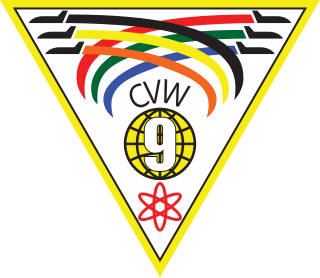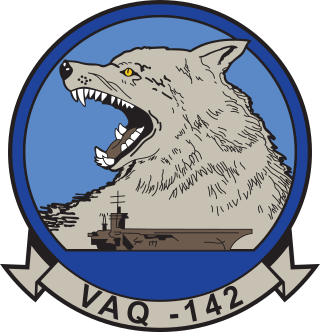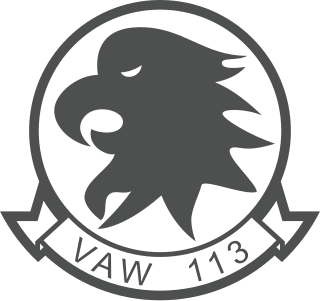
USS Carl Vinson (CVN-70) is the United States Navy's third Nimitz-class supercarrier. She is named for Carl Vinson (1883–1981), a congressman from Georgia, in recognition of his contributions to the U.S. Navy. The ship was launched during Vinson's lifetime in 1980, undertook her maiden voyage in 1983, and underwent refueling and overhaul between 2005 and 2009.

Sea Control Squadron 21 (VS-21) was an aviation unit of the United States Navy. It served from 1945 to 2005 and was mainly tasked with anti-submarine warfare while operating from aircraft carriers. It was the only squadron to receive the designations VA-1E, VC-21, or VS-21.

Electronic Attack Squadron 135 (VAQ-135), known as the "Black Ravens", is a United States Navy electronic attack squadron that currently operates the EA-18G Growler carrier-based electronic warfare jet aircraft. The squadron is permanently stationed at Naval Air Station Whidbey Island with a radio callsign of "Thunder".

Strike Fighter Squadron 147 (VFA-147), also known as the "Argonauts," is a United States Navy strike fighter squadron that is currently being transferred to MCAS Iwaukuni, Japan. VFA-147 was established on 1 February 1967 and flies the F-35C Lightning II, becoming the first non-training F-35 squadron in the U.S. Navy and will become the first forward-deployed F-35 squadron.

Carrier Air Wing Nine (CVW-9) is a United States Navy aircraft carrier air wing based at Naval Air Station Lemoore. The Air Wing is currently assigned to the aircraft carrier USS Abraham Lincoln (CVN-72). The Tail Code of aircraft assigned to CVW-9 is NG.

Strike Fighter Squadron 146 (VFA-146) also known as the "Blue Diamonds" is a United States Navy operational fleet strike fighter squadron based at Naval Air Station Lemoore California. They fly the F/A-18E Super Hornet and are attached to Carrier Air Wing 17, deployed aboard USS Nimitz. Their tailcode is NA and their radio callsign is Diamond.

Electromagnetic Attack Squadron 142 (VAQ-142), also known as "The Gray Wolves", is an EA-18G Growler squadron of the United States Navy stationed at Naval Air Station Whidbey Island, Oak Harbor, Washington. Their tailcode is AJ and their ATC callsign is "GRIM".

Strike Fighter Squadron 34 (VFA-34), also known as the "Blue Blasters", is a United States Navy F/A-18E Super Hornet strike fighter squadron stationed at Naval Air Station Oceana. They are a part of Carrier Air Wing 11 and are attached to the aircraft carrier USS Theodore Roosevelt. Their tail code is NH and their radio call sign is "Joker".

Carrier Air Wing Two (CVW-2) is a United States Navy aircraft carrier air wing based at Naval Air Station Lemoore. The air wing is currently attached to the aircraft carrier USS Carl Vinson (CVN-70).

Carrier Air Wing Eleven (CVW-11) is a United States Navy aircraft carrier air wing based at Naval Air Station Lemoore, California. The air wing is attached to the aircraft carrier USS Theodore Roosevelt.

Carrier Air Wing Fourteen (CVW-14), was a United States Navy aircraft carrier air wing based at Naval Air Station Lemoore, California.

Helicopter Sea Combat Squadron Four (HSC-4), also known as the Black Knights, is a multi-role combat helicopter squadron of the United States Navy based at Naval Air Station North Island which operates Sikorsky MH-60S Seahawk helicopters deployed aboard aircraft carriers. The squadron was originally established as HS-4 on 30 June 1952 at U.S. Naval Auxiliary Landing Field Imperial Beach with the Sikorsky HO3S-1 and was redesignated HSC-4 on 29 March 2012. It is currently assigned to Carrier Air Wing Two (CVW-2) which deploys aboard USS Carl Vinson (CVN-70).

Airborne Command & Control Squadron 117 (VAW-117) is an airborne early warning (AEW) and command and control (C2) squadron. Nicknamed "The Wallbangers,” it flies the E-2D Hawkeye, the only carrier-capable command and control aircraft. The squadron is based in NAS Point Mugu and deploys as part of Carrier Air Wing 9 (CVW-9) on board USS Abraham Lincoln.

Sea Control Squadron 22 (VS-22) Checkmates was a carrier-based United States Navy squadron based out of Naval Air Station Jacksonville in Florida. The squadron flew the Lockheed S-3B Viking and their mission was mining, undersea and surface warfare, electronic reconnaissance and analysis, over the horizon targeting, and aerial refueling. The squadron was last attached to Carrier Air Wing Seventeen (CVW-17) and was the last squadron flying the Viking. VS-22 was disestablished in a ceremony at NAS Jacksonville on 29 January 2009, and officially on 31 March 2009.

Airborne Command & Control Squadron 113 (VAW-113), known as "Black Eagles", was established on 20 April 1967 flying the E-2A Hawkeye.

Helicopter Sea Combat Squadron SIX (HSC-6), is a helicopter squadron of the United States Navy. It was established as Helicopter Antisubmarine Squadron SIX (HS-6) on 1 June 1956. Its nickname is Screamin’ Indians. On 8 July 2011 it was redesignated Helicopter Sea Combat Squadron SIX (HSC-6). It is based at Naval Air Station North Island, is part of Carrier Air Wing 17 and deploys aboard the aircraft carrier USS Nimitz (CVN-68).

Carrier Air Wing Fifteen (CVW-15) is a former United States Navy aircraft carrier air wing that was decommissioned on 31 March 1995. It was previously known as Carrier Air Group Fifteen (CVG-15) before 1963 before being renamed in December of that year.
The United States Navy sent their naval forces in the Red Sea and Persian Gulf including six Aircraft Carriers to take part in Operation Desert Storm, including others that arrived before or after the war started and ended. USS Abraham Lincoln CVN-72

Sea Control Squadron 37 or VS-37 also known as the "Sawbucks" was an Anti Submarine Warfare squadron that was decommissioned in 1995 along with CVW-15. During its active history, it flew during the Korean and Vietnam Wars as well as operating the last S-2 Trackers inservice with the US Navy in 1975.

Sea Control Squadron 38 or VS-38, nicknamed the "Red Griffins" was a former United States Navy Anti-Submarine Warfare and later Sea-Control squadron between 1950 and 2004. During its service life, they took part in the Korean War, Vietnam War, the 1991 Gulf War and the 2003 Invasion of Iraq.





















